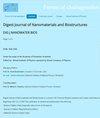Terahertz detection of chemicals through zeonex fiber material
IF 1
4区 材料科学
Q4 MATERIALS SCIENCE, MULTIDISCIPLINARY
Digest Journal of Nanomaterials and Biostructures
Pub Date : 2023-04-01
DOI:10.15251/djnb.2023.182.511
引用次数: 0
Abstract
A PCF sensor is proposed for chemical (e.g., glycerol, acetic acid, and water) sensing through Zeonex fiber material. We investigate relative sensitivity, effective are, effective material loss, and confinement loss to analyze the sensor performance. The proposed sensor offers the relative sensitivity of almost 97.7% for glycerol, 96.25% for acetic acid, 95.28% for water at frequency 3.5 THz. In addition, the sensor possesses small effective material loss and tiny confinement loss that are important characteristics of an efficient chemical sensor. Furthermore, the modern fabrication techniques are well fitting for the fabrication of the presented sensor.通过zeonex纤维材料太赫兹检测化学品
提出了一种PCF传感器,用于通过Zeonex纤维材料进行化学(如甘油,乙酸和水)传感。我们研究了相对灵敏度、有效损耗、有效材料损耗和约束损耗来分析传感器的性能。在3.5太赫兹频率下,该传感器对甘油的相对灵敏度接近97.7%,对乙酸的相对灵敏度为96.25%,对水的相对灵敏度为95.28%。此外,该传感器具有小的有效材料损失和小的约束损失,这是一个高效的化学传感器的重要特征。此外,现代制造技术很适合该传感器的制造。
本文章由计算机程序翻译,如有差异,请以英文原文为准。
求助全文
约1分钟内获得全文
求助全文
来源期刊

Digest Journal of Nanomaterials and Biostructures
工程技术-材料科学:综合
CiteScore
1.50
自引率
22.20%
发文量
116
审稿时长
4.3 months
期刊介绍:
Under the aegis of the Academy of Romanian Scientists
Edited by: -Virtual Institute of Physics operated by Virtual Company of Physics.
 求助内容:
求助内容: 应助结果提醒方式:
应助结果提醒方式:


